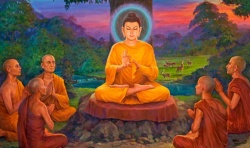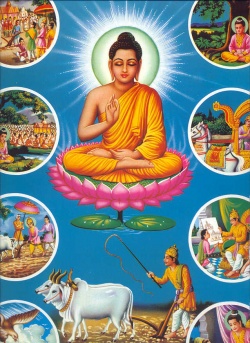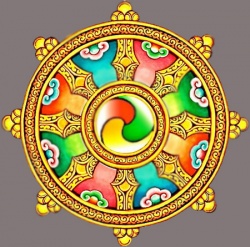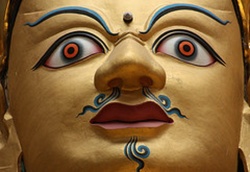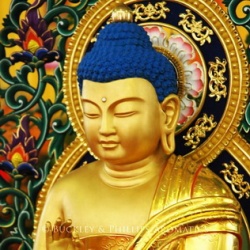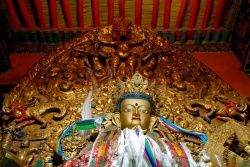Buddhist Paths to liberation
The Buddhist tradition gives a wide variety of descriptions of the Buddhist Path to liberation . The most notable of these descriptions is the Noble Eightfold Path , which was presented in the first discourse of the the Buddha and is considered the essence of the Buddhist path (magga ).
The Noble Eightfold Path is typically presented as a set of eight interconnected factors or conditions, that when developed together, lead to the cessation of dukkha (suffering ). Alongside the eightfold path , Buddhist texts present a number of other "paths" that describe the path in different ways according to different traditions .
Noble Eightfold Path
The Noble Eightfold Path is presented as the fourth of the Buddha 's Four Noble Truths and it is considered to be the essence of Buddhist practice. For example, Bhikkhu Bodhi states:
- The essence of the Buddha’s teaching can be summed up in two principles:
the Four Noble Truths and the
Noble Eightfold Path
The first covers the side of doctrine , and the primary response it elicits is understanding; the second covers the side of discipline , in the broadest sense of that word, and the primary response it calls for is practice.
The Noble Eightfold Path consists of a set of eight interconnected factors or conditions, that when developed together, lead to the cessation of dukkha .
These eight factors are:
Right View (or Right Understanding ),
Right Intention (or Right Thought ),
Right Mindfulness , and
Ajahn Sucitto describes the path as "a mandala of interconnected factors that support and moderate each other."
The eight factors of the path are not to be understood as stages, in which each stage is completed before moving on to the next.
Rather, they are understood as eight significant dimensions of one's behaviour—mental , spoken, and bodily —that operate in dependence on one another; taken together, they define a complete path , or way of living.
The eight factors of the path are commonly presented within three divisions (or higher trainings) as shown below:
| Division | Eightfold factor | Sanskrit, Pali | Description |
|---|---|---|---|
| Wisdom (Sanskrit: prajñā, Pāli: paññā) |
1. Right view | samyag dṛṣṭi, sammā ditthi |
Viewing reality as it is, not just as it appears to be |
| 2. Right intention | samyag saṃkalpa, sammā sankappa |
Intention of renunciation, freedom and harmlessness | |
| Ethical conduct (Sanskrit: śīla, Pāli: sīla) |
3. Right speech | samyag vāc, sammā vāca |
Speaking in a truthful and non-hurtful way |
| 4. Right action | samyag karman, sammā kammanta |
Acting in a non-harmful way | |
| 5. Right livelihood | samyag ājīvana, sammā ājīva |
A non-harmful livelihood | |
| Concentration (Sanskrit and Pāli: samādhi) |
6. Right effort | samyag vyāyāma, sammā vāyāma |
Making an effort to improve |
| 7. Right mindfulness | samyag smṛti, sammā sati |
Awareness to see things for what they are with clear consciousness; being aware of the present reality within oneself, without any craving or aversion | |
| 8. Right concentration | samyag samādhi, sammā samādhi |
Correct meditation or concentration, explained as the first four jhānas |
Alongside the eightfold path, Buddhist texts present a number of paths that describe the path in different ways according to different traditions. Generally speaking, these alternative methods of presentation are not considered to be contradictory, but rather as different ways to present the Buddhist path.
Theravada Buddhism
The classical outline of the Theravada path to liberation are the Seven Purifications, as described by Buddhaghosa in the Visuddhimagga.
These purifications are:
- Purification of Conduct (sīla-visuddhi)
- Purification of Mind (citta-visuddhi)
- Purification of View (ditthi-visuddhi)
- Purification by Overcoming Doubt (kankha-vitarana-visuddhi)
- Purification by Knowledge and Vision of What Is Path and Not Path (maggamagga-ñanadassana-visuddhi)
- Purification by Knowledge and Vision of the Course of Practice (patipada-ñanadassana-visuddhi)
- Knowledge of contemplation of rise and fall (udayabbayanupassana-nana)
- Knowledge of contemplation of dissolution (bhanganupassana-nana)
- [[Knowledge of appearance as terror]] (bhayatupatthana-nana)
- Knowledge of contemplation of danger (adinavanupassana-nana)
- Knowledge of contemplation of dispassion (nibbidanupassana-nana)
- [[Knowledge of desire for deliverance)] (muncitukamyata-nana)
- Knowledge of contemplation of reflection (patisankhanupassana-nana)
- Knowledge of equanimity about formations (sankharupekka-nana)
- Conformity knowledge (anuloma-nana)
- Purification by Knowledge and Vision (ñanadassana-visuddhi)
The "Purification by Knowledge and Vision" is the culmination of the practice, in four stages leading to liberation and Nirvana.
The emphasis in this system is on understanding the three marks of existence,
This emphasis is recognizable in the value that is given to vipassana over samatha, especially in the contemporary vipassana movement.
Atthakavagga
The Atthakavagga, one of the oldest books of the Pali canon's Sutta Pitaka, contained in the Sutta Nipata, does not give a clear-cut goal such as Nirvana, but describes the ideal person.
This ideal person is especially characterized by suddhi (purity) and santi (calmness).
Commentaries on the Atthakavagga, namely the Mahaniddesa and the commentary by Buddhaghosa, show the development of Buddhist ideas over time.
Both commentaries place the Atthakavagga in their frame of reference, giving an elaborated system of thought far more complicated than the Atthakavagga itself.
Bodhisattva Path
The Bodhisattva Path advances through ten stages, referred to as the "bodhisattva bhūmis" ("enlightenment-being grounds/levels").
The Sanskrit term bhūmi literally means "ground" or "foundation", since each stage represents a level of attainment and serves as a basis for the next one.
Each level marks a definite advancement in one's training that is accompanied by progressively greater power and wisdom.
The Avatamsaka Sutra refers to the following ten bhūmis:
- The Very Joyous (Skt. Paramudita), in which one rejoices at realizing a partial aspect of the truth;
- The Stainless (Skt. Vimala), in which one is free from all defilement;
- The Luminous (Skt. Prabhakari), in which one radiates the light of wisdom;
- The Radiant (Skt. Archishmati), in which the radiant flame of wisdom burns away earthly desires;
- The Difficult to Cultivate (Skt. Sudurjaya), in which one surmounts the illusions of darkness, or ignorance as the Middle Way;
- The Manifest (Skt. Abhimukhi) in which supreme wisdom begins to manifest;
- The Gone Afar (Skt. Duramgama), in which one rises above the states of the Two vehicles;
- The Immovable (Skt. Achala), in which one dwells firmly in the truth of the Middle Way and cannot be perturbed by anything;
- The Good Intelligence (Skt. Sadhumati), in which one preaches the Law freely and without restriction;
- The Cloud of Doctrine (Skt. Dharmamegha), in which one benefits all sentient beings with the Law (Dharma), just as a cloud sends down rain impartially on all things.#
The bhūmis are subcategories of the Five Paths (pañcamārga, Wylie Tibetan lam lnga):
- The path of accumulation (saṃbhāra-mārga, Wylie Tibetan: tshogs lam). Persons on this Path:
- The path of preparation or application (prayoga-mārga, Wylie Tibetan: sbyor lam). Persons on this Path:
- Start practicing meditation;
- Have analytical knowledge of emptiness.
- The path of seeing (darśana-mārga, Wylie Tibetan: mthong lam) (Bhūmi 1). Persons on this Path:
- Practice profound concentration meditation on the nature of reality;
- Realize the emptiness of reality.
- The path of meditation (bhāvanā-mārga, Wylie Tibetan: sgom lam) (Bhūmi 2-7). Persons on this path purificate themselves and accumulate wisdom.
- The path of no more learning or consummation (aśaikṣā-mārga, Wylie Tibetan: mi slob pa’I lam) or thar phyin pa'i lam) (Bhūmi 8-10). Persons on this Path have completely purified themselves.
Tibetan Buddhism
Lam Rim
Lam Rim describes the stages of the path. Tsong Khapa mentions three essential elements:
- The aspirationh for awakening
- Bodhicitta, the aspiration to attain this for all living beings
Annuttara-yoga tantras
In the highest class of tantra, two stages of practice are distinguished, namely generation and completion.
In some Buddhist tantras, both stages can be practiced simultaneously, whereas in others, one first actualizes the generation stage before continuing with the completion stage practices.
Generation stage
In the first stage of generation, one engages in deity yoga.
One practices oneself in the identification with the meditational Buddha or deity (yidam) by visualisations, until one can meditate single-pointedly on being the deity.
Four purities
In the generation stage of Deity Yoga, the practitioner visualizes the "Four Purities" (Tibetan: yongs su dag pa bzhi; yongs dag bzhi) which define the principal Tantric methodology of Deity Yoga that distinguishes it from the rest of Buddhism:
- Seeing one's environment as the pure land or mandala of the deity
- Perceiving one's enjoyments as bliss of the deity, free from attachment
- Performing one's actions only for the benefit of others (bodhichitta motivation, altruism)
Completion stage
In the next stage of completion, the practitioner can use either the path of method (thabs lam) or the path of liberation ('grol lam).
At the path of method the practitioner engages in Kundalini yoga practices.
These involve the subtle energy system of the body of the chakras and the energy channels.
The "wind energy" is directed and dissolved into the heart chakra, where-after the Mahamudra remains, and the practitioner is physically and mentally transformed.
At the path of liberation the practitioner applies mindfulness, a preparatory practice for Mahamudra or Dzogchen, to realize the inherent emptiness of every-'thing' that exists.
Four yogas of mahāmudrā
Mahāmudrā' literally means "great seal" or "great symbol".
The name refers to the way one who has realized mahāmudrā.
"Mudra" refers to the fact that each phenomenon appears vividly, and "maha" refers to the fact that it is beyond concept, imagination, and projection.
Mahāmudrā is sometimes divided into four distinct phases known as the four yogas of mahāmudrā.
They are as follows:
- One-pointedness;
- Simplicity, "free from complexity" or "not elaborate";
- One taste;
- Non-meditation, the state of not holding to either an object of meditation nor to a meditator.
Nothing further needs to be 'meditated upon' or 'cultivated at this stage.
These stages parallel the four yogas of dzogchen semde.
The four yogas of Mahāmudrā have also been correlated with the Mahāyāna five Bhumi paths.
Zen
Although the Zen-tradition emphasises sudden awakening over the study of scripture, in practice several stages can be distinguished.
A well-known example are the Ten Ox-Herding Pictures which detail the steps on the Path.
Sudden and gradual
Once the dichotomy between sudden and gradual was in place, it defined its own logic and rhetorics, which are also recognizable in the distinction between Caodong (Soto) and Lin-ji (Rinzai) chán.
But it also lead to a "sometimes bitter and always prolix sectarian controversy between later Chán and Hua-yen exegetes".
In the Huayan classification of teachings, the sudden approach was regarded inferior to the Perfect Teaching of Hua-yen.
Guifeng Zongmi, fifth patriarch of Hua-yen ànd Chán-master, deviced his own classification to counter this subordination.
Guifeng Zongmi also softened the edge between sudden and gradual.
In his analysis, sudden awakening points to seeing into one's true nature, but is to be followed by a gradual cultivation to attain Buddhahood.
Chinul, a 12th-century Korean Seon master, followed Zongmi, and also emphasized that insight into our true nature is sudden, but is to be followed by practice to ripen the insight and attain full Buddhahood.
To establish the superiority of the Chán-teachings, Chinul explained the sudden approach as not pointing to mere emptiness, but to suchness or the dharmadhatu.
This is also the standpoint of the contemporary Sanbo Kyodan, according to whom kensho is at the start of the path to full enlightenment.
This gradual cultivation is described by Chan Master Sheng Yen as follows:
- Ch'an expressions refer to enlightenment as "seeing your self-nature".
But even this is not enough. After seeing your self-nature, you need to deepen your experience even further and bring it into maturation.
You should have enlightenment experience again and again and support them with continuous practice.
Even though Ch'an says that at the time of enlightenment, your outlook is the same as of the Buddha, you are not yet a full Buddha.
Rinzai-Zen
In Rinzai, insight into true nature is to be followed by gradual cultivation.
This is described in teachings such as The Three mysterious Gates of Linji, and the Four Ways of Knowing of Hakuin.
Sōtō-Zen
Although Sōtō emphasizes shikan-taza, just-sitting, this tradition too had description of development within the practice.
This is described by Tozan, who described the Five ranks of enlightenment



